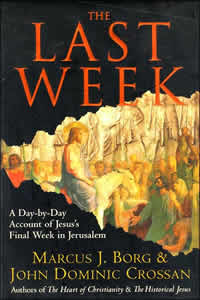Book Notes
 Marcus Borg and John Dominic Crossan, The Last Week; A Day-by-Day Account of Jesus's Final Week in Jerusalem (San Francisco: Harper, 2006), 220pp.
Marcus Borg and John Dominic Crossan, The Last Week; A Day-by-Day Account of Jesus's Final Week in Jerusalem (San Francisco: Harper, 2006), 220pp.
In this simple exposition written for a general audience, two leading New Testament scholars use the Gospel of Mark to explain what happened to Jesus during his final week. They use Mark because most scholars consider it the earliest of the four Gospels, the primary source for Matthew and Luke, and because when you read carefully you see that Mark details the last eight days of Holy Week, from Palm Sunday through Easter Sunday. He even specifies "morning" and "evening" for three of these days:
Palm Sunday: "When they were approaching Jerusalem" (11:1)
Monday: "On the following day" (11:12)
Tuesday: "In the morning" (11:20)
Wednesday: "It was two days before the Passover" (14:1)
Maundy Thursday: "On the first day of Unleavened Bread" (14:12)
Good Friday: "As soon as it was morning" (15:1)
Holy Saturday: "The Sabbath" (15:42, 16:1)
Easter Sunday: "Very early on the first day of the week" (16:2).
Mark even describes what happened at five three-hour intervals on Good Friday (pp. ix-x). The book, then, consists of eight chapters, one for each day of Holy Week.
For Borg and Crossan the gospels are not records of straightforward historical facts remembered by the author, but stylized interpretations of the believing community. There's an element of truth in this, of course; you could say the same about nearly all written history. But I'm sometimes dubious about historical reconstructions two millennia after the events that claim to know more and to know better than the first witnesses, or that do not give compelling explanations about how and why the first recorders got things so badly wrong and yet attracted the allegiance of so many converts (who must have known they were "wrong" about the literal facts).
Borg and Crossan do a wonderful job of illuminating the religious background of first century Judaism and especially the centrality of the temple, and the cultural and political background of the Roman empire, showing how the Biblical texts and these two contexts interact. If you've read any of Borg's many books, it will come as no surprise that the authors understand the "passion" of Jesus not as a sacrifice or substitution (as it has been understood by much if not most of Christendom), but as an incarnation of God's justice which subverts the status quo of political oppression, economic exploitation, and religious legitimation. The 2007 edition of this book has the sensational sub-title What the Gospels Really Teach About Jesus's Final Days in Jerusalem.


